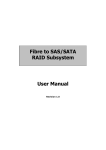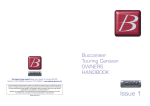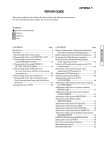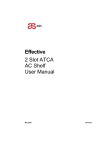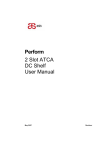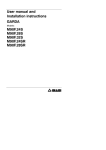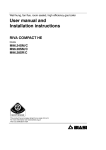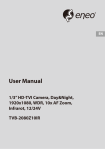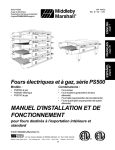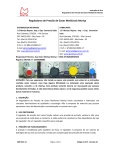Download User`s Manual
Transcript
Osiris 10 manual Osiris 10 10kW Grid Tie Wind Turbine User Manual Ver. 1.1 Osiris(Shanghai) Technologies Co., Ltd. F3, No.3 Building, No.335 Guoding Road,Yangpu District, Shanghai, 200433, China TO BE INSTALLED, MAINTAINED AND REPAIRED BY TRAINED PERSONNEL ONLY 1 Osiris 10 manual Congratulations on your purchase and welcome to our family! Dear Osiris Owner, Thank you for your purchase of Osiris. You have just selected the most technologically advanced, cost-effective renewable energy appliance available for a home or small business. We congratulate you on your choice and are confident you will experience years of dependable service. Before going any further, please complete and return the enclosed Warranty Registration Card. The conditions of your warranty are dependent upon the proper installation of Osiris. Furthermore, this will assure you of being kept up-to-date with the latest developments from Osiris Energy. These include new options, performance tips, updated software to maximize output and user notices. It is important to know that we do not sell or distribute your information to any third party. We understand your privacy is important. If you have any questions or comments, we would like to hear from you. Please call during working hours (MondayFriday - 8:00 am to 4:30 pm Beijing Time). Our telephone number is 0086-21-35030699. Again, welcome to our family and thank you for investing in the future of wind energy with Osiris. Sincerely Osiris Energy Co., Ltd Enter the serial and model number below Serial Number Model Number 2 Osiris 10 manual Revision History Revision Date Description of Change Initial 0 19/02/2012 First issue GH 1 10/05/2012 Minor Amendments and Additions GH 2 26/05/2012 Tower bolt details Amendments GH 3 02/08/2012 Tool list additions GH 4 18/09/2012 Updated system wiring diagram GH 5 07/11/2012 Minor amendments. Inc tool list changes GH 6 04/01/2013 Update Condition of maintenance and checking GH 7 22/02/2013 Updated 3 Month service guidance GH 8 16/04/2013 Minor Amendment of Package form in 2.5 GH 3 Osiris 10 manual Important Safety Instructions READ THESE INSTRUCTIONS IN THEIR ENTIRETY BEFORE INSTALLING OR OPERATING. ● professional installation highly recommended 1) SAVE THESE INSTRUCTIONS. This manual contains important instructions for Osiris that must be followed during installation and maintenance. 2) Read, understand and respect all warnings. 3) Do not install Osiris around standing water. 4) Do not install Osiris on a windy day. 5) Always obtain a building permit before construction. 6) When moving Osiris or any heavy objects to the site, use a cart to prevent back injury. 7) If unusual noise or abnormal operation is observed from Osiris, turn off the machine and contact authorized service personnel. 8) Shut Osiris “OFF” if ice accumulates on blades to avoid possible injury resulting from ice flying off blades. 9) This wind generator complies with international safety standards and therefore the design or its installation must never be compromised. a. Do not open the inverter cover, doing so without factory authorization will void the warranty. b. Do not paint the blades. 10) Osiris must be installed in accordance with this manual and local and national building codes. Failure to comply with the manual and local codes will affect and possibly void your warranty. In case of any need please contact us at: Osiris Energy Co., Ltd. Tel: +86 21 3503 0699 Fax: +86 21 3503 0633 [email protected] 4 Osiris 10 manual Table of contents 1. Introduction.....................................................................................................................................................................................8 1.1 Technical Specification......................................................................................................................................................8 2. System Description........................................................................................................................................................................9 2.1 Rotor and Blades................................................................................................................................................................ 9 2.2 Generator............................................................................................................................................................................. 9 2.3 Nacelle............................................................................................................................................................................... 10 2.4 Control System..................................................................................................................................................................10 2.5 Package contents..............................................................................................................................................................11 3. Health and Safety........................................................................................................................................................................12 4. Turbine Siting............................................................................................................................................................................... 13 4.1 Planning Permission.........................................................................................................................................................13 4.2 Location..............................................................................................................................................................................14 4.3 Safety Zones..................................................................................................................................................................... 15 4.4 Multiple Installations........................................................................................................................................................15 4.5 Noise.................................................................................................................................................................................. 15 4.6 Shadow Flicker................................................................................................................................................................. 16 5. Mechanical Installation............................................................................................................................................................... 16 5.1 Foundations.......................................................................................................................................................................16 5.2 Tower..................................................................................................................................................................................16 5.2.1 Weights.................................................................................................................................................................. 16 5.2.2 Installation procedure.......................................................................................................................................... 16 5 Osiris 10 manual 5.2.3 Tower Raising....................................................................................................................................................... 20 5.2.4 Earthing.......................................................................................................................................................................... 21 5.2.5 Lightning Protection............................................................................................................................................. 23 5.3 Turbine Head.................................................................................................................................................................... 24 5.3.1 Nacelle Assembly.................................................................................................................................................24 5.3.2 Fitting Blades........................................................................................................................................................ 30 5.3.3 Pitch operation and test.......................................................................................................................................33 5.3.4 crane and hoist operation............................................................................................................................................ 36 6. Electrical System Installation.....................................................................................................................................................37 6.1 General Description......................................................................................................................................................... 37 6.1.1 Osiris Turbine controller...................................................................................................................................... 37 Turning On/Off Voltage for Diversion...................................................................................................................................37 6.1.2 Osiris Dump load.................................................................................................................................................. 39 6.1.3 Osiris Wind Turbine pitch controller.................................................................................................................. 39 6.1.4 Osiris Inverters......................................................................................................................................................40 6.2 Signs and Labels.............................................................................................................................................................. 41 7. Commissioning............................................................................................................................................................................ 43 7.1 Tests................................................................................................................................................................................... 43 7.2 Start-up.............................................................................................................................................................................. 43 7.3 Certification Requirements..............................................................................................................................................44 7.4 Documentation Requirements........................................................................................................................................44 8. Turbine Operation........................................................................................................................................................................45 6 Osiris 10 manual 8.1 Starting Up.........................................................................................................................................................................45 8.2 Running..............................................................................................................................................................................45 8.3 Protective operation......................................................................................................................................................... 47 8.4 Stop the wind turbine....................................................................................................................................................... 48 8.5 Disconnect from the grid................................................................................................................................................. 49 9. Maintenance and Inspections....................................................................................................................................................50 Condition of maintenance and checking...............................................................................................................................50 9.1 Service Schedule..............................................................................................................................................................50 9.2 Annual Inspection.............................................................................................................................................................50 10. Appendix.....................................................................................................................................................................................54 10.1 Appendix 1 - Tool List....................................................................................................................................................54 10.2 Appendix 2 - Troubleshooting Guide........................................................................................................................... 54 10.3 Appendix 3 - Inverter Display Message and Settings............................................................................................... 55 10.4 Appendix 4 - Foundation Sign Off Certificate.............................................................................................................57 10.5 Appendix 5 - Installation Checklist.............................................................................................................................. 58 10.6 Appendix 6 - Installation Sign Off Sheet.....................................................................................................................60 10.7 Appendix 7 - Maintenance / Service Log....................................................................................................................61 10.8 Appendix 8 - Service Report Sheet.............................................................................................................................63 7 Osiris 10 manual 1. Introduction This manual contains important information concerning your Osiris 10 wind turbine. It is strongly recommended that you read and familiarize yourself with its contents before installing, operating or maintaining the turbine. This manual gives a minimum standard that Osiris expects all installations to comply to. Installers are required to be accredited and members of authorized organization and should ensure that installations comply with all requirements as part of these accreditations. Installers are also required to keep abreast of current legislation and should ensure all installations comply with the most up to date legal requirements. Particular attention should be given to any changes in local Standards and related requirements. Where changes in this legislation improve on the standards in this document the new guidance should be taken to overrule the information given in this manual. The Osiris 10 turbine is a reliable, well engineered machine backed up with an impressive 5 year warranty. At Osiris we are confident that with proper installation and maintenance the turbine will run successfully and reliably for many years to come. 1.1 Technical Specification Turbine Type Downwind Horizontal Axis Rated Power Output 10kW @ 9.5m/s Annual power supplied Approx 31,166 kWh at 6m/s, or greater & stronger winds RPM Variable. 120rpm at max generation Cut In Wind Speed 3.0m/s Maximum rated wind speed 59.5m/s Blades 3 x carbon fiber reinforced glass fiber construction Speed Control Passive Pitch and Active Pitch Combined Additional Safety Systems Electrical and manual pitch control, automatic brake dump load Rotor Diameter 9.7m Head weight 850kGs 8 Osiris 10 manual 2. System Description The Osiris 10 is a downwind, horizontal axis, low RPM direct drive, permanent magnet wind turbine, designed to self regulates using a unique passive and active pitch system. With a peak rated output of 10kW at 9.5m/s the Osiris 10 is specifically designed for high reliability, low maintenance and automatic operation in adverse weather conditions. Practical and perfect for supplying electricity to properties such as farms, large residences, offices, businesses and public buildings, an Osiris wind turbine allows you to generate your own green energy, effectively reducing your carbon footprint and publicly promoting your commitment to renewable energy. 2.1 Rotor and Blades The rotor system consists of three molded fiber glass blades and carbon fiber blades. This method of production is very rare in the small turbine market and is usually only reserved for large MW size turbines. The blades are manufactured in house under a strict ISO 9001 quality system and are not bought in from an outside supplier. This ensures we have total quality control at all times and that we are confident that each blade is made to our exacting standards. The blades convert the energy of the wind into rotational forces that drive the generator. The blades are carefully balanced in the factory before delivery to ensure smooth operation of the wind turbine and are supplied as a matched group. The blades are painted in impact resistant two-pack paint and have carbon fiber reinforced leading edges to ensure strength and durability. A passive blade pitch mechanism limits the maximum rotational speed of the rotor. The mechanism consists of 4 springs and mechanical linkages attaching these to the blade root. The pitch setting is factory set and the whole mechanism is a fail-safe design, meaning that the RPM will be limited to a lower speed if the springs weaken or fail. This means that the turbine can self limit its top speed even in the heaviest winds or when the load is disconnected. The wind loading on the blades also acts to orientate the turbine correctly in the wind, removing the need for a tail vane or yaw motor. This greatly improves the reliability of the turbine and reduces maintenance times and costs. 2.2 Generator The generator converts the rotational energy of the rotor into electricity. It is built using rare-earth permanent 9 Osiris 10 manual magnets and has no touching parts or brushes meaning that it is maintenance free. The permanent magnet generator is designed to produce power at low rotational speeds, eliminating the need for a gearbox. Again this greatly increases reliability with the added benefit of lower noise and more efficient operation. The output from the generator is three-phase variable frequency and variable voltage (directly proportional to rotor speed). The generator is robust can be physically disconnected from the load at any time without any problems - in this case the output voltage will rise and the turbine will speed up slightly until the pitch system controls the turbine at its maximum rpm. WARNING: A PERMANENT MAGNET GENERATOR PRODUCES A VOLTAGE WHENEVER THE ROTOR IS TURNING - CAUTION MUST BE EXERCISED AT ALL TIMES TO AVOID ELECTRICAL SHOCK. 2.3 Nacelle The nacelle is the main body of the turbine and contains the structural backbone of the wind turbine. It houses and protects the generator, manual pitch system, yaw bearing and brush gear from the elements. The mainframe is manufactured from steel and is protected with a hot dip galvanized finish. The removable glass fiber generator cover enables easy access to the generator and other components, whilst giving a clean and modern finish. 2.4 Control System The turbine control system is made up of the following parts. Unlike other turbine manufacturers we manufacture our own control system and inverters, enabling these to be matched exactly to the performance of our turbines. This increases reliability, improves efficiency and reduces installation time. Turbine Controller The turbine controller is the first stage of the control system. This takes the electricity generated by the turbine and rectifies it ready for the control system inverters. The controller also contains overvoltage protection and can bring in braking resistors to help control the turbine in high winds. Turbine Pitch Controller Osiris pitch controller (Model No.: GPC-01), which supports both automatic pitching and manual pitching; the rated input voltage is DC24V. GPC-01 can adjust the length of pitch pushing rod to fit the RPM of wind turbine, the wind turbine could be safeguarded even under storm wind or strong breeze Braking Resistors The braking resistors are used to help slow the turbine down when the control system detects that the wind speed is very high or in case of grid failure. They are only used rarely when required by the control system and do not waste ‘useful’ power: the energy dumped is in addition to the published power curve. The use of braking resistors ensures that the turbine is always under control and that the inverters are protected from harmful high voltages in the event of a grid failure. 10 Osiris 10 manual Inverters The inverters are custom made to suit the Osiris 10 wind turbine and are matched exactly to its power curve for optimum efficiency. Setup is quick and easy and there is no complicated programming required. The inverters take the rectified power from the turbine and construct perfect, grid quality electricity which meets all requirements of related national grid. The inverters are easy to connect and can be configured for single phase or three phase installation. As the inverters are specifically designed for wind turbines rather than PV they have the widest voltage tolerance of any inverter on the market. They are designed to cope with overvoltage of up to 600V with no adverse effects. 2.5 Package contents Before you begin, inspect the contents to make sure there is no damage or missing parts. Package form Box No. 1 2 3 Wind turbine parts Quantity Blade (with mounting plate) 3 pcs 2-1 Generator assembly 1 pcs 2-2 Standard parts 1 set 2-3 Anemometer 1 pcs 3-1 2kW Inverter 6 pcs 3-2 Controller 1 pcs 3-3 Dump load 2 pcs 3-4 Pitch controller 1 pcs 3-5 Transformer 1 pcs Remark Size (mm) 4410 x 710 x 630 4410 x 710 x 630 1130 x 1020 x 1100 Packing list and notice: Your Osiris wind generator is shipped in three boxes (standard parts of tower and naked pack tower are optional) Box one: rotor blades (three pcs) ● Box dimensions: 4410 x 710 x 630 ● Weight: 218 kg Upon opening, carefully inspect each of the blades to make sure there are no fractures or cracks in the surfaces. Although the Osiris rotor blades are comprised of a durable carbon fiberglass, damage can occur to the blades during shipping. Once inspected, be sure to set them away from the construction site and protect them from any damage until they are ready for assembly. 11 Osiris 10 manual Box two: Osiris 10 wind generator assembly ● Box dimensions: 2180 x 1090 x 1200 ● Weight: 903 kg Your Osiris comes in several versions in accordance with local utility requirements. Be sure to inspect the package and confirm you have the right voltage and frequency. If you have ANY questions, call your dealer or the factory before continuing. Box three: Osiris 10 electrical & mechanical parts(inverter, controller, transformer, dump load and pitch controller) ● Box dimensions: 1130 x 1020 x 1100 ● Weight:: 352 kg Optional box: standard parts for tower ● Box dimensions: 850 x 50 x 190 ● Weight: 325 kg ● Naked pack tower could weight up to 3500kgs, the detail of its specification can be found in Osiris tower manual. 3. Health and Safety The long term safety of the wind turbine depends on a number of issues that both system designer and installer must address. Potential hazards need to be identified and eliminated or minimized. This does not just include those which may be present during installation but also any that may develop over time. Poor installation can compromise the long term safety of the system. Equally, unsafe site and working conditions can put installation engineers at risk. Correct design of the system as well as thorough planning of the installation phase will help to ensure the quality of the installation as well as the safety of the work team. INSTALLERS NEED TO TAKE NOTE OF THEIR STATUTORY DUTIES UNDER HEALTH AND SAFETY LAW AND ARE RESPONSIBLE FOR ENSURING COMPLIANCE WITH THE LAW. The Construction (Design and Management) Regulations may also apply if more than four people will be involved in the construction work at any one time. The project is notifiable to the Health & Safety organization if it will exceed 30 days or involve more than 500 person-days of work. However, there are exceptions to this. As part of standard Health & Safety practice, a Risk Assessment should be completed. Special attention should be given to the following points: ● Due regard should be given to any public rights of way close to the installation site ● The specific local situation should be taken into account, e.g. the likely presence of children or animals ● Existing site services (e.g. overhead or underground electric cables) should be identified and exclusion zones defined ● Temporary signs, notices and barriers should be erected ● The local weather conditions should be considered. Osiris does not recommend the installation of turbines in wind speeds greater than 6 m/s ● Structural and mechanical installation must be actively managed and supervised by a suitably experienced and competent person ● Before each day’s operations commence all workers involved in the works must be fully briefed on the day’s 12 Osiris 10 manual events and method statements in a toolbox talk. This is to include the identification of danger areas and potential health and safety issues identified in the risk assessments ● All personnel must wear appropriate personal protective equipment, including high visibility jackets, hard hat and safety boots ● During installation and maintenance works, an exclusion zone shall be established to prevent persons not engaged with erection of the turbine from gaining admittance ● Standard precautions for working with rotating machinery should be taken: long hair should be tied back; loose clothing avoided; rings, necklaces and other jewelry removed 4. Turbine Siting Osiris project preparation There are several considerations before you begin the installation process of your Osiris. These considerations are more important if you intend to connect your machine to the electrical utility. Although Osiris is IEC 61400-2 certified, your local utility and zoning authority may require additional information prior to installation. This chapter will provide an overview of what to expect when working with your zoning authority. Working with your Local Zoning Authority Call your local electric utility, tell them your intentions and ask for their “Interconnection Agreement”. They should have one. Depending on your utility, the interconnection agreement may be one page or many. Keep in mind that small utility-connected wind systems are relatively new industries and utility connection requests may be unfamiliar to them. If you are the first, realize the process may take longer. Osiris Energy has people and tools that may assist in the process. Your utility may request documentation demonstrating that Osiris is IEC 61400-2 certified. You can download the Certificate of Compliance at our website: www.osirisenergy.com 4.1 Planning Permission The planning authority may impose restrictions on the sitting of a wind turbine. These restrictions are normally due to two reasons: ● Expected noise output ● Visual impact on the landscape These restrictions will be particular strong in areas of outstanding beauty. However it should be noted that this does not mean that planning will not be granted and there are lots of examples of Osiris size wind turbines installed in these areas. 13 Osiris 10 manual The customer should be made aware of any restrictions that might occur. In assembling information for the local planning authority, the latest planning guidance and recommendations should be taken into account. In support of a planning application, installers should: ● Advise customers to make contact with the local planning authority themselves ● Urge customers to communicate with neighbour and the local community about the project at an early stage ● Provide information to the authority on similar installations (location, equipment type, etc) ● Provide appropriate drawings ● Provide information on noise levels Osiris can provide a Planning Pack on request which contains a lot of useful information for use during planning application. 4.2 Location The ideal site for a wind turbine is on a smooth, rounded and exposed hill-top or rise; one clear of any cliff faces and many meters from obstructions such as trees and buildings. In practice this very rarely happens. Where it is not possible to achieve the ideal location the additional risks and Health & Safety considerations must be carefully weighed. When locating a wind turbine there is normally a compromise between 5 main factors: Wind direction: a turbine should be exposed to prevailing winds, i.e. the direction with the best overall combination of frequency and strength. Obstacles: wind speed increases with height as the ground and objects close to it disrupt air flow. The 'roughness' of the ground is a measure of the way obstacles such as trees, buildings and the surface topography act to effectively slow down the wind. When sitting a wind turbine the installer should take account of possible future obstructions such as tree growth. The wind turbine should ideally be placed well clear of any buildings, obstructions and places where the public may gather. Turbulence: the flow of the wind is disrupted when it passes over or around objects, so a turbine should be sited to minimize the influence of obstacles (ideally from all directions). Excessive turbulence may also cause fatigue and shorten a turbine's life. Tower height: while greater height will increase energy output (higher wind speed and less turbulence, especially at sites of greater roughness), practical considerations such as cost and ease of lowering (for maintenance) also need to be taken into account. Cable Length: losses from cables will result in a reduction of overall energy output. Cable runs should therefore be kept as short a possible for optimum performance. The cost of underground cabling may also prove excessive if long cable runs are planned. 14 Osiris 10 manual 4.3 Safety Zones The Osiris 10 is designed with safety first are foremost. Despite this, serious mechanical failures could in theory lead to parts falling from the wind turbine. In preparing a site risk assessment the following safety zones should be taken into account Zone Zone Radius around turbine 1 Tower Height 2 Tower Height + Blade Length Hazard Falling Part Guidance Exclusion zone. In public areas this should be protected using fencing Tower Collapse Part thrown Low occupancy zone. This area should generally be kept clear and occupied no more than 3 person hrs per day 3 50m Part thrown Average occupancy zone, typical occupation of 200 person hours per day 4.4 Multiple Installations Where multiple installations are intended at a single site extra care should be taken. This includes ensuring that no turbine is in the wind shadow of another turbine and also that there is adequate space to lower each turbine to the ground. Osiris recommended a spacing of a minimum of 3.5 x rotor diameters apart to prevent interference. 4.5 Noise Modern wind turbines such as the Osiris 10 are designed specifically to minimize noise using a direct drive generator which operates without a gearbox and has a low rpm whilst maximizing power production. This means that the only noise is that caused by the swish of the blades in the wind and this is often masked by the background noise in the area. However despite this, customers should be made aware of the expected noise levels and given clear and honest advice about what the noise levels mean. As a rough guide the minimum distance from properties should be at least 6 x rotor diameters. 15 Osiris 10 manual 4.6 Shadow Flicker Shadow flicker is an effect caused when the sun passes behind the rotors of a spinning wind turbine and casts a shadow of the blades over neighboring properties. The further the away from the wind turbine, the less pronounced the effect becomes. Flicker effects have been proven to only occur within ten rotor diameters of a turbine. 5. Mechanical Installation 5.1 Foundations See separate foundation installation guide for details. The foundations should be installed a minimum of two weeks before turbine installation. 5.2 Tower 5.2.1 Weights Base Section Bottom Section Middle Section Top Section 12 m Tower 280kg 1170kg 634kg 15m Tower 366kg 1470kg 910kg 594kg 5.2.2 Installation procedure The tower installation must be carried out with certified lifting slings. A nominated signal man must be used to direct the lift and ensure the lift is carried out in a controlled and safe manner. The lift area should be cordoned off and no unauthorized personnel should be allowed to enter. The importance of leveling the tower can not be underestimated. The Osiris 10 is a downwind passive yaw turbine and as such can experience yaw problems if the tower is not adequately leveled. Levels should be checked throughout the tower installation to ensure the tower is not pulled out of level. The tower installation should only take place in winds less than 6m/s ● Lift parts off vehicle using slings. Ensure that the lift is correctly balanced and that the vehicles lift capacity is adequate for the work. ● Take tower sections to foundation and layout in the correct positions for assembly. 16 Osiris 10 manual ● Raise up 3 of the M30 foundation nuts (at 120 degrees from each other) by three turns so that the three nuts are around 2mm higher than the others. Using the spirit level adjust the nut heights until the three nuts are level. M30 nut ● Lift up the base section and lower over the foundation bolts resting the piece onto the three raised nuts. Make sure that the hinge section is correctly aligned with the hydraulic cylinder base plate. ● Once the base section is lowered double check the level of the top flange. If the level is more than 0.15 degrees out of level then readjust the base bolt height to ensure that top flange is level. ● Once the top flange is level install the washers, lock washers and top nuts onto the three leveling foundation bolts. The nuts should be pre tightened gradually together whilst watching the spirit level, always ensuring that the top flange remains level. 17 Osiris 10 manual ● Once the three leveling bolts are tightened the remaining nuts can be brought up under the flange. Installer washers, lock washer and top nuts onto the foundation bolts. Whilst still watching the spirit level bring all M30 bolts up to 1350Nm using hydraulic torque wrench. It is best to do this by torquing bolts in a cross pattern to ensure the flange remains level. ● Next install the hydraulic cylinder base pad onto the 4 cylinder foundation bolts. Install the fixing nuts and torque up to 1100Nm. ● Lift up the hydraulic cylinder using a sling through the pin hole and move into location above the cylinder base plate. Insert the fixing pin through the cylinder and base plate and tighten up the nut. When tight it should still be possible to move the cylinder around the fixing pin. ● Using a steel trestle it should now be possible to support the cylinder at a 35 degree angle ready for the installation of the lower tower section. ● Connect up the hydraulic power pack to the lift cylinder using the supplied hoses. Fixing should be tightened to around 80Nm. The power pack should be connected to the mains supply and be filled with hydraulic oil. It is recommended that the operation of the power pack and cylinder is confirmed before proceeding with the installation. ● Lift the lower tower section using the lifting vehicle. The lower section should be installed onto the hinge pin and the hydraulic cylinder attached to the tower. To help with this the tower should be supported on trestles. The cylinder can be raised or lowered using the power pack to aid this fixing. 18 Osiris 10 manual ● Lift top section of tower into position and align flanges with the tower. Ensure the cable loops inside the tower are aligned. ● Bolts flanges together using M24 bolt, washers, and spring washers. Cross fasten the nuts and bring up to 650Nm. ● The tower generator power cable and earthing cable should now be threaded down the tower, ensuring it passes through each cable loop. The use of thin cable rods is recommended to make this process easier. Please note that the tower cable is not provided by Osiris. ● The tower is now ready for head installation. Ensure the tower is well supported and is not relying on the lift cylinder to support its weight. For head installation instructions see the section below. 19 Osiris 10 manual 5.2.3 Tower Raising ● Once the head has been installed the tower can be raised. Start the hydraulic power pack and manually rotate the pressure valve to raise the tower. When using the hydraulic power pack it is important to keep the flow rate low, ensuring the flow rate is slow and uniform. If the flow rate is too high the tank may vibrate and jitter which could cause damage to components. ● Once the tower is raised the final set of bolts can be fastened. Fit with M30 bolts, washers and spring washers, tighten to 1400Nm. The level should be checked using a digital spirit level against the vertical sides of the tower. Each flat face should be equally angled. 20 Osiris 10 manual ● After tower installation, remove the cylinder and store safely. 5.2.4 Earthing The earthing system of Osiris 10 was connected by generator outer wire and main cable through the slip ring. The grounding should be finish by the customer. When wind turbine and grounding network is completed, the measurement of grounding resistance must be ≤4Ω. (see Fig. below) In particular, in order to ensure the reliability of lightning protection system, the infrastructure construction should abide by following precautions: A. Earthing network choose galvanized flat iron (min. cross sectional size 50x5. ) B. 3 sets of galvanized flat iron of Grounding network reaching toward the center of foundation, and welding together with vertical and horizontal steel as a whole. C. The aforesaid 3 sets of galvanized flat iron reaching out the concrete surface of foundation ring and welding with the ear plate of tower tube wall. 21 Osiris 10 manual Osiris 10 electrical system connected to earthing Each part of the Osiris 10 electrical system (including controller, pitch controller, inverter, dump load and transformer) has separate grounding point. The following is electrically system connection chart (Fig. 3). Each grounding point of the component were joined at one point , then connected to grounding network as chapter.2 show with 6mm2 wire. The exact earthing of the turbine is at the discretion of the system designer and depends on the particular site and ground conditions. If in doubt about tower earthing please seek professional assistance. In general the following recommendations should be followed ● The turbine tower is to be connected to a dedicated earth electrode. An electrode resistance to earth not exceeding 10 Ohms should be achieved, though may not be justifiable in some cases. ● The earth electrode shall be placed as close as is practical to the tower base and it must be installed in such a way as to permit periodic inspection. Periodic inspection is important as a failure of this earth termination may have a serious impact on the system, not least in the transmission of lightning surges. ● The connection between the tower and the tower earth should be made with copper cable (minimum CSA of 16mm2), taking a direct route and avoiding sharp bends. ● Separation between the turbine earth and building earth is to be maintained. This is to ensure that any direct strikes on the turbine (which may be in a particularly exposed location) are not coupled directly back to the building. ● The steel wire armor of the turbine output cable should not be coupled in any way to the tower earth and so bring the turbine earth inside the building. This could occur if a metal junction box is used to join cables within the steel turbine tower; the metal box would be coupled to the armored sheath by the SWA gland and also coupled to the tower by direct contact. In such a situation, a non-conductive enclosure must be used. ● An earth wire should be taken up the turbine tower and connected to the earth wire from the nacelle. This earth wire passes through the earthing brush gear and ensures the nacelle body is connected to the tower earth. 22 Osiris 10 manual 5.2.5 Lightning Protection The anti-lightning system of Osiris 10 takes the steel bar of the foundation as grounding, the steel bar was welded with electrical penetration, avails the metallic characteristic of the wind turbine body to connect anchor bolt and steel bar (of the grounding) - [see fig. 1] In particular, in order to ensure the reliability of lightning protection system, the infrastructure construction should abide by following precautions: A. The electrical penetration of foundation steel bar should be dealt with properly, at least to ensure the outer circle is penetrated, bridging materials - 12MM round steel, welding length around 150MM. B. Each corner of the foundation has a down-lead, the down-lead should be 2x16mm or 4x14mm steel bar. C. The anchor bolt should be installed stably, to ensure down-lead and wind turbine body connected as a whole. takes the steel bar of the foundation as grounding, the steel bar was welded with electrical penetration, avails the metallic characteristic of the wind turbine tower to connect anchor bolt and steel bar (of the grounding) -Fig. 1 The electrical system of Osiris 10 (including controller, pitch controller, inverter, dump load and transformer) has 23 Osiris 10 manual indoor installation and outdoor electrical cabinet installation, for the indoor one, it should reach the household Lightning protection standard; for the outdoor electrical cabinet, it should be connected to the tower Lightning protection point by 10 mm2 cable. The design of inverter and other electrical appliance also adopted piezo-resistor B72220S0301K10 in design, to prevent lightning or the voltage transients of electrical system jeopardizing circuit. The Appendix is the specification and VDE certificate of the piezo-resistor. The likelihood of damage may be caused either by a direct strike or through surges induced in cables from a nearby strike. Tower earthing (see above) provides one element of protection. a) Dedicated Lightning Protection Systems If there is a risk of a direct strike, specialists should be consulted about installing a separate LPS b) Surge Protection Cabling systems can be designed to provide a degree of surge immunity. The following measures will act to shield the cables from inductive surges and attenuate surge transmission (by increasing inductance): ● Turbine output cables should be as short as possible, bundled together and not looped ● Long turbine output cables (for example, those over 50m) should have an earth shield, which can be created by using earthed, armored cable or earthed metal conduit/trunking Surge suppression devices will give additional protection: ● Where these are fitted to the turbine output cable, they should be attached at the tower base. In the case of long cable runs, they should be fitted at both ends ● Where surge suppression devices are fitted to protect specific equipment, they should be fitted as close as is practical to the device ● Surge suppression devices must be electrically safe and pose no electrical fire hazard 5.3 Turbine Head To enable easy fitting of the nacelle it is usual to lift the tower to a suitable working height, usually with the hub at shoulder height. This can be done using the hydraulic power pack and cylinder; however once at height it is important that the tower is supported using trestles near the head end. NEVER WORK UNDER THE TURBINE WHILST RELYING ON THE LIFT CYLINDER TO HOLD THE WEIGHT. THE TOWER SHOULD ALWAYS BE SUPPORTED BY OTHER MEANS IN CASE OF LIFT CYLINDER FAILURE. 5.3.1 Nacelle Assembly ● Unpack the nacelle and inspect for any signs of damage. The enclosed parts should also be checked against the packing list. If any parts are damaged or missing then please contact Osiris immediately and log as nonconforming goods. Damaged areas should be photographed as evidence of damage occurring during shipping. 24 Osiris 10 manual No Name Number 1 Wind turbine 1set 2 Manual pitch handle 1 set 3 Anemometer 1 set 4 Standard parts 1 set Remark 1 2 3 4 ● Open up the top cover of the nacelle exposing the brush gear and manual pitch mechanism. Again check for any internal damage and contact Osiris immediately if there are any concerns. Lifting point ● Unbolt the lower nacelle cover from the main frame. There are four brackets holding the lower cover on as shown below. 25 Osiris 10 manual ● Once the brackets are undone the top flange needs to be unbolted from the wooden transportation frame. This can be quite tricky and we recommend the use of a swivel ended socket spanner suitable for an M16 bolt (sometimes referred to as a scaffolding spanner). ● Once the lower cover is removed the mainframe and generator can be lifted out of the bottom cover and placed in a safe location. There are installed eyebolts on the generator and subframe and these should be used along with rated lifting slings and shackles to get a balanced lift. ● Remove the electric actuator, then mount the M30 lifting ring and sling. 26 Osiris 10 manual Lifting point ● Next lift the lower cover and slide over the tower top. ● Next the main frame should be lifted using one sling and shackle on the mainframe lifting eye and the 1T chain block in the generator lifting eye. Once the mainframe is lifted on the ground the chain block should slowly be lowered to rotate the main frame into a vertical orientation (with nose towards the ground). ● Move the nacelle next to the top tower flange. Align the flanges so that they are approximately 300mm apart. This is to allow electrical cables to be connected and pitch wire to be threaded down the tower. 27 Osiris 10 manual ● Pull the three power cables and two earth cables from the nacelle flange. These should be connected to the tower cables using terminal bloc connectors. Also ensure that the tower earth cable is attached to the nacelle earthing cable (Please note this should be from the tower earth and should be isolated from the building earth). ● Pull the steel rope up from its location in the nacelle and pass over the pulley wheel and through the base of the mainframe. ● Thread a cable rod down the tower and attach this to the end of the steel wire. Pull the wire through the length of the tower to the base. ● The manual pitch handle should then be assembled in the base of the tower. Thread the steel wire through this so that the system will grip the wire and allow it to run over the free moving bolts when turned. ● Once all cables are connected the two flanges should be brought together and fastened using M16x60 hexagon bolt, washers, and lock washers. These should be fastened to 320Nm. 28 Osiris 10 manual ● Remove the sing and M30 lifting ring, then install the electric actuator. When power is on, a manual pitch and a return pitch test should be taken by pitch controller to ensure normal pitch operation. THE CENTRAL AXIS OF φ10.5 HOLE (FOR M10 BOLT) ON THE HOLDER FOR FIXING THE ELECTRIC ACTUATOR MUST BE IN PARALLEL WITH THE CENTRAL AXIS OF ROTATING SHAFT, OTHERWISE IT WILL DAMAGE ELECTRIC ACTUATOR AND COMPONENTS OF PITCH MECHANISM WHEN THE ACTUATOR ACTS. ● Once the flanges are fastened to the correct torque, pull up the bottom nacelle cover and fasten onto the generator base plate using M10 x 35 bolts and nuts. ● Once the lower cover is installed the turbine is now ready for blade installation. 29 Osiris 10 manual 5.3.2 Fitting Blades ● Unpack the blades from their packing crate. Be careful when opening to ensure the blades do not fall out. Treat the blades with exceptional care - especially the leading and trailing edges of the airfoil. The blades are supplied as a balanced and matched set of three and must be installed together on a single turbine. ● To enable easy fitting of the blades it is usual to lift the tower to a suitable working height, usually with the hub at shoulder height. This can be done using the hydraulic power pack and cylinder; however once at height it is important that the tower is supported using trestles near the head end. NEVER WORK UNDER THE TURBINE WHILST RELYING ON THE LIFT CYLINDER TO HOLD THE WEIGHT. THE TOWER SHOULD ALWAYS BE SUPPORTED BY OTHER MEANS IN CASE OF LIFT CYLINDER FAILURE. ● Take care to fit the blades in the correct orientation. Note that the blades turn in a clockwise direction when viewed from the front of the rotor (i.e. anticlockwise when looking down on the blades). It is possible to fit the blades in the opposite direction and this could lead to dangerous situations occurring therefore installers should check carefully before bringing the bolts to full torque. ● Before installing the blades ensure that the blade hub covers are installed on the turbine. 30 Osiris 10 manual ● The blades may be bolted onto any position of the three blade hubs and it is essential to support the blades weight whilst they are being installed. When connecting the blades to the blade hubs start inserting the M12*50 bolts from the front side of the blade hub and secure with the provided lock nuts and washer. The bolts should be torqued to 70Nm in two steps: First torque all bolts in an even progression up to 45Nm, then to 70Nm. ● After all three blades have been fitted and bolts torqued wait 30mins before re-checking torque. ● Before install the upper cover of nacelle, the connector of anemometer needs to go through the hole of upper cover and be fixed with M bolt. ● Connect the connector with anemometer by hand, then install the anemometer on the upper cover of nacelle, one of bolts on the anemometer must be blocked in the groove and the other must be screwed down by hand, then rotate 3 cups of anemometer slightly, and check the display of pitch controller to ensure that the anemometer has 31 Osiris 10 manual output of wind speed data. ● Next the nose cone should be fitted using M8 and M10 bolts. The blade hub covers should also be fastened to this. Once the nose cone is in place, turn the rotor to check for any interference between nose cover and main turbine head body. ● The manual pitch should now be tested and checks should be made for interference between blade bolts and the hub covers. If interference does occur the nose cone should be adjusted. ● Finally the top cover can be fitted and the turbine is now ready for erection. Pitch handle installation (after tower erection) ● Remove the M12x50 hexagon bolt and M12 locknut from the handle. ● Make the M12x50 hexagon bolt go through the hole from inside to outside at the bottom of the tower circular opening, and screw down the M12 locknut. ● After remove the M10x50 hexagon bolt and colonnette from the handle, insert the handle into the big hole at the bottom of the tower circular opening. ● Fix the colonnette and wire rope on the handle with 2 pcs of M10x50 hexagon bolts, then make the wire rope go through the gap between the colonnette and the handle, and fix the end of wire rope with rope clip (should be at 32 Osiris 10 manual the lower side of the handle). 5.3.3 Pitch operation and test ● Turn the handle slowly, and the wire rope starts to twist the handle. When turn the handle, the force on it is increased slowly, as soon as a sudden force is felt, the manual pitch has reached the end. Here the blades should rotate with an obvious angle. When the wind speed exceeds a proper scope, the blades will reverse after pitch operation. ● Make the upper hole of disk on the handle aim at M12 blot after pitch operation and insert into it. AFTER TURN THE HANDLE, WHEN THE WIRE ROPE BECOMES STRAINED, 3 CIRCLES’ HANDLE TURNING ARE NEEDED FOR A FULL PITCH OPERATION, THE FORCE OF HANDLE TURNING SHOULD NOT BE GREATER THAN 500N. ● Move the handle out with hand first when return the pitch and then reverse the handle quickly, the blades will be seen rotating obviously. When the wire rope twisted on the handle is fully cast loosed, the return pitch operation is finished. Pitch handle installation 5.3.3.1 Pitch handle installation procedure A. Dismantle M12x50 hexagon headed bolt and M12 locknut from the pitch handle. 33 Osiris 10 manual B. Put the M12x50 hexagon headed bolt inside-out through the small hole of the tower, and then fasten the M12 locknut. C. After dismantle M10x50 hexagon headed bolt and column bar from the handle, insert the handle into the big hole of the tower. D. Install wire rope clip on one end of the wire rope, remember to tight it firmly. And fasten another M10x50 hexagon headed bolt on the other end. 34 Osiris 10 manual E. Use 2 pcs M10x50 hexagon headed bolt to fasten column bar and the wire rope onto the pitch handle, the wire rope should thread through the loophole between wire rope and column bar. 5.3.3.2 Manually control the pitch A. Sway the handle slowly (clockwise or counter- clockwise), the wire rope begins to twine the handle, while the force on handle will increase, when the force becomes very big suddenly, which means the manual pitching has reaching its threshold, the rolling of impeller will speed down obviously until stop, and some times counter rolling. IMPORTAT: AFTER SWAYING THE HANDLE, MANUAL PITCHING WILL REACH ITS THRESHOLD AT 3 TO 4 CIRLE COUNTING FROM THE TIGHTENING OF THE HANDLE, THE FORCE OF SAWYING SHOULD NOT TOO MUCH (SAMLLER THAN 500N) B. Keep pitching After pitching manual (impeller stop or counter rolling), push the handle toward tower slowly, if the small hole on the handle can’t aligning the bolt, the handle need to be sway backward, until the alignment of the small hole and the handle, then put the small hole of the handle onto the bolt to prevent it from swaying. If the impeller keep counter rolling, the handle could be pulled out and change to the position of another small hole to prevent it from swaying. 35 Osiris 10 manual C. Pitch restoring Stir the handle outward, to make it separate from the M12 bolt of the tower completely. Counter rolling the handle until the wire rope un-tighten completely. 5.3.4 crane and hoist operation Requirement on crane and hoist 1. The load-bearing of machine should bigger than 12 ton 2. The hanging height should higher than 20m 3. Two separate function wire rope hanger is necessary 4. The load-bearing of hoist cable should bigger than 10 ton 5. The minimum load-bearing of the hoisting part, such as: hoisting pad, hanger and shackle etc is 10 ton. The operation of crane and hoist 1. All operation should be carried out according to the specific professional regulation issued by relevant authorities, correct and safety operation is a must. 2. There must not be anybody stand under the arm or the hanging stuff during operation. 36 Osiris 10 manual 6. Electrical System Installation All work is to be undertaken by experienced, competent and authorised personnel who are fully familiar with standard working practices within the electrical industry and who are acquainted with the maximum voltages present on the system being installed. Live working practices are to be adopted during the initial connection of the turbine to the main output cable Subsequently, the turbine isolator must be secured open for all other works on the electrical system. Relying only on the pitch or shorting brake to prevent against shock is not acceptable. 6.1 General Description The main components of the electrical system are: 6.1.1 Osiris Turbine controller This provides the interface between the turbine and the grid connect inverter. The Turbine Controller converts the three phase AC output of the wind turbine to DC for input to the inverter. (transmit power to grid through the inverter. The rated output power of controller is 20 kw, which includes power transmitted to both inverters and diversion load. Normally, there is no current through diversion load. When the wind is too strong and the output voltage is too high, the diversion circuit will work and redundant power will be divided to the load; when the inverter failed to connect grid, the output voltage of generator will be higher, and then the power from generator will be transmitted to diversion load by power-leader. By detecting output voltage, power-leader can protect the whole system. Turning On/Off Voltage for Diversion User can regulate diversion voltage by switching unit U1. Switch Mode and Diversion Voltage Switch U1 Mode Voltage (Vdc) 1, 2 OFF VON=400, VOFF=300 1 ON, 2 OFF VON=500, VOFF=400 1 OFF, 2 ON VON=500, VOFF=400 1, 2 ON VON=600, VOFF=500 37 Osiris 10 manual It also has the ability to help control the turbine speed in high winds by bringing in the braking resistors to slow the turbine down. It does this by detecting a rise in the DC voltage above a preset level. If this is detected the control system will gradually divert the surplus current to the brake resistors. The current diversion is performed using advanced high frequency, pulse width modulation (PWM) switching to ensure smooth control of the turbines speed. The brake resistors are simply resistive elements that are used to dissipate the power generated by the turbine. They are only used in extreme conditions or in the event of turbine technical problems, however when used they may get hot. The choice of location should be carefully considered and they should be placed out of reach and at least 500mm from any other risks of fire. An ideal location would be high up on an outside wall. The three wires of Generator connected to IN1,IN2,IN3; The resistor box’s two white wires shall be connected to B1,B2, and the yellow/green one connected to G; DC+,DC- are the output dc ends, connected to inverter’s input terminals; the right terminal G connected to building earth. There are two dip switches located in the controller. By default these should be set 1on and 2 off. It is important to check these settings before starting up the turbine. 38 Osiris 10 manual Dial Switch Dump Load Switch-on Voltage / V Dump Load Switch-off Voltage / V 1,2 off Default: 1on 2 off or 1 off 2 on 1,2 on 310 410 230 330 510 410 6.1.2 Osiris Dump load Function ● transform the over electric energy of wind turbine Characteristic of Ginlong inverter: ● Made up of aluminum shell resistors ● Used in small wind turbine system ● Protect electrical equipments when wind speed is grater than rated speed of blade perfectly. 6.1.3 Osiris Wind Turbine pitch controller Osiris pitch controller (Model No.: GPC-01), which supports both automatic pitching and manual pitching; the rated input voltage is DC24V. GPC-01 can adjust the length of pitch pushing rod to fit the RPM of wind turbine, the wind turbine could be safeguarded even under storm wind or strong breeze The electrical connection of GPC-01 should be abide by the following steps: 1. Make sure the wind turbine stop running and then open the controller cabinet for connecting 3 phase wires. 2. Connecting the relevant terminals to its matching equipment accordingly. 39 Osiris 10 manual The pitch controller will take different pitching actions according to the wind speed and data collected by setup points. Setup points Setup points meaning and action 10m/s Implement pitching, while >10m/s wind speed continues for 300s 15m/s Implement pitching, while >15m/s wind speed continues for 60s 25m/s Implement pitching, while >25m/s wind speed continues for 2s, and then wind turbine will stop 8m/s Pitching recover, while wind speed drops to <8m/s, continues for 600s 450Vac Implement pitching, when detecting the rectified generator output busbar voltage>450V 20V Implement pitching, when detecting the battery voltage<20V 6.1.4 Osiris Inverters There are three optional scheme in electrical system of Osiris 10. A scheme consists 2 x 5kW inverters in parallel as a 10KW single phase inverter. B scheme consists 3 x 3.6kW inverters in parallel as a 10.8KW three phase inverter. C scheme consists 6 x 2kW inverters in parallel as a 12KW three phase inverter. The inverters must be programmed so that the built in automatic protection system operates at: ● Operating voltage greater than 247V phase to neutral ● Operating voltage less than 207V phase to neutral 40 Osiris 10 manual ● Operating frequency greater than 50.5Hz ● Operating frequency less than 47.5Hz ● Loss of mains / islanding prevention The inverters are specifically designed to match the output of the Osiris 10 wind turbine and should come preprogrammed with the Osiris 10 power curve. Currently, for different scheme in electrical system, a corresponding converter group will be provided for the inverters to be connected to. 6.2 Signs and Labels Labeling must be provided at the service termination, meter position and all isolation points in order to indicate the presence of on-site generation and to show the position of the main AC switch isolator. At the interconnection point, the following is also to be displayed: ● Circuit diagram ● Summary of protection settings that have been incorporated in the equipment ● A contact telephone number for the supplier/installer/maintainer of the equipment. ● A detailed emergency shutdown procedure 41 Osiris 10 manual All labels must be clear, easily visible and should be constructed and fixed so as to remain legible and in place throughout the design life of the system. Example labels are shown below: 42 Osiris 10 manual 7. Commissioning 7.1 Tests Though Osiris is thoroughly tested at the factory, it is very important to conduct one more test prior to erecting the tower and operation. Osiris wind turbine should be wired and mounted to the top of the tower. The blades should not be attached. To do this test, you must have all wires and breakers installed with at least one disconnect switch open (off). While the tower is in an horizontal position, isolate the controller first, and then check for generator circuit continuity and insulation to ground with the generator leads disconnected at the turbine connection box. Resistance between all three lines should be equal. Insulation resistance to ground using a 500V insulation tester should be more than 2 Meg. After the tower has been raised check the operation of the manual pitch mechanism. If the wind speed is less than approximately 6m/s an open circuit test can be performed before connecting the turbine to the control system. Release the shorting brake and release the pitch to full setting. The turbine should begin spinning and the rotor should turn freely without significant vibration. If vibration appears excessive further investigation will be required before installation can be complete. Whilst the turbine is running off-load check that the voltages between all lines of the output cable are equal using a digital multimeter. (Due to the varying frequency we recommend that a true RMS meter is used). The voltages between phases should be approximately equal (they will vary slightly due to gusting of the wind between readings). A full electrical test of the system should be performed before proceeding with turbine startup. 7.2 Start-up At the start of commissioning ensure that: ● The turbine shorting switch is on ● The pitch brake is on ● The turbine is isolated from the grid connect inverters ● The grid connect inverter is isolated from the grid To startup the turbine: ● Turn on the Turbine MCB installed in the customer distribution board 43 Osiris 10 manual ● Turn on the isolator labeled ‘Point of AC Isolation’ ● At this stage if the main is within the set parameters the G59 relay should energise (if included) ● Turn on the isolator labeled ‘Point of Turbine Isolation’. We recommended that this isolator is only switched when the wind turbine is stationary to prolong the life of the unit. ● Switch off the turbine shorting switch ● Release the pitch brake ● The turbine will start to rotate if wind conditions are more than about 4m/s. At first release the turbine may sometimes take a small time to begin turning due to grease in the bearings. ● The inverter waits until input DC voltage is above a certain level before starting its self test and safety procedures. At this point the inverters start monitoring grid AC voltage, frequency and impedance. After a few seconds the GREEN LED starts to flash. If all is OK then it waits 180 seconds and then connects to the grid. 7.3 Certification Requirements Inspection and testing of the completed system must be carried out to the requirements. Accurate performance testing of a turbine is only possible where an anemometer reading at the hub height is available. For most small systems, such data will not be available. Readings from the system display meter will often be the only means to determine how well the system is working. 7.4 Documentation Requirements The following must be provided to the customer: ● Turbine foundation specifications - including, where appropriate, an assessment of local ground conditions as well as the installation requirements, specification of materials, etc ● Drawings, specifications and instructions for assembly, installation and erection ● This installation, maintenance and operation manual ● IEC authorized test certificate if applicable ● Commissioning certificate ● The customer should also be made aware that they should inform their insurance company of the wind turbine installation 44 Osiris 10 manual 8. Turbine Operation If very high winds are expected such as wind speed greater than 25m/s it is recommended to manually change the pitch and apply the short circuit isolator. If extremely high winds are expected (e.g. 42m/s) we recommended that the turbine is put on brake and the tower lowered. During strong winds (wind speed of more than 9m / s) there may be some slight rocking of the tower and turbine head. This is normal and is expected behavior. 8.1 Starting Up Remove the short circuit brake Hold onto the manual pitch lever to prevent sudden movement as the locking bolt is removed. Remove the locking bolt and then slowly let the handle turn to remove pitch. When the handle is stationary, remove the rope from the wheel to allow the pitch to be fully returned to normal. In very high winds or when there is a turbine fault it may be necessary to apply the pitch brake. In these situations care should be taken as the turning force required will be greater. 8.2 Running Once running the turbine requires no user intervention. The following gives an overview of the expected wind turbine behavior. Behavior in no / low wind: ● Inverter goes into wait mode after disconnecting from grid network ● If wind increases then the inverter will start up. Behavior in Medium Wind up to 12m/s. ● Inverters automatically adjust power output depending on windspeed Behavior in High Winds above 12m/s: Inspection Item Wind Turbine Inspection Content The First Three Months Every Year Every 5 Years Blade √ √ Blade Bolt M16x60 √ √ Rotor(Hub, Rotating Shaft etc.) √ √ 45 Osiris 10 manual Generator √ √ Engine Base Platform √ √ Slip Ring √ √ Pitch Grease XHP223 Tower and Foundation Electrical System Remarks √ Anemometer √ √ Electric Actuator √ √ Nacelle √ √ Tower √ √ Tower Fastener √ √ Foundation Bolt M30 √ √ √ Foundation √ √ √ Inverter √ √ √ Controller √ √ √ Dump Load √ √ √ Connecting Wire √ √ √ Battery √ √ √ 1. When a wind turbine experience an extremely high wind (≥42.5m/s), sales agent or aftersales service agent should inform end users for related enquiry and inspection. 2. A wind turbine should be fully inspected after a strong wind (≥25m/s) within one year. 3. The main inspection content:If mechanical components show phenomena as crack, wear (it will lead to accidents, but a normal running friction not contained), falling parts, burnt-out generator etc.;If the mechanism operation is abnormal and if electrical parts show burning-out, open circuit, alarm and other abnormal phenomena. ● Pitch mechanism will adjust blade pitch to maintain the 10kW output ● If the pitch mechanism can not control the 10kW limit the control system will gradually bring in brake resistors to control the speed further 46 Osiris 10 manual 8.3 Protective operation A. Manual pith control Pitch operation 1). Press the “up” or “down” button on the pitch controller, and choose pitch control on the menu. Information Pitch control Setting Alarm message 2). Press the “select” button, and select “pitch enable” to activate pitching Pitch enable Pitch disable 3). Wait for 30s to finish pitching, normally the impeller will speed down obviously until stop, and some times counter rolling. (less than 60rpm) NOTICE: COUTER PITCHING MAY OCCURE, WHEN MANUAL PITHING CONTINUES FOR 20 MINS Counter pitch operation 2). Press the “up” or “down” button on the pitch controller, and choose pitch control on the menu. Information Pitch control Setting Alarm message 2). Press the “select” button, and select “pitch disable” to activate counter pitching Pitch enable Pitch disable 3). Wait 30s for the finish of counter pitching B. Manual short-circuit brake 1). Condition Under normal condition, the rpm of the impeller should be less than 70rpm (the display power of single inverter should be less than 1kW) If the rpm of the impeller faster than 90rpm (the display power of single inverter should be less than 1.2kW), the shortcircuit brake may de-functioned. 2). Operation Turn the short-circuit switch from “OFF” to “ON”, impeller should stop or roll slowly (under heavy wind) 47 Osiris 10 manual short-circuit switch If the impeller fail to speed down or stop, the switch should be turned to “OFF”, wait for the speed down timing to switch it to “ON” C. Emergency pitch 1). Press the emergency stop button, and the pitch begin to work. The button won’t be bounced back in a short time. Remark: Emergency pitch does not have a counter pithing effect. 2). Restoration of emergency pitch Press the emergency stop button again, the button bounce back, and the pitch system will work normally. 8.4 Stop the wind turbine A. Stop for maintenance Operation: 1). Normal pitch operation plus short-circuit brake Or 2). Manual pitch operation plus short-circuit brake 48 Osiris 10 manual B. Normal stop Operation: Normal pitch operation C. Emergency stop Emergency stop is not recommended, unless the following situation happen A. The wind turbine run abnormally, while the professional technician is absence. B. Call the installer for help, presence or absence C. Call Osiris hot line and follow instruction Operation: emergency pitch plus short circuit. D. periodic testing of emergency shutdown/overspeed system ● An emergency shut down test should be operated every six month ● The overspeed system test should be operated every six month, or when the wind speed >50m/s 8.5 Disconnect from the grid Disconnect from the grid is not recommended, unless the following situation happen A. Voltage of the grid is abnormal (affect the usage from home appliance) or when the grid line is on fire B. The operation should be made out by qualified technician Operation: Turn the main grid tied switch from “on” to “off” Connection should be restored as soon the situation return to normal. 49 Osiris 10 manual 9. Maintenance and Inspections Condition of maintenance and checking A. Temperature between -10℃ ~ 35℃ B. Wind speed < 7.5m/s C. Not in an unfavorable weather condition such as: heavy raining, storm and hail stone D. Prepare proper tools and equipments: high-pressure oil gun Grease XHP223 E. Pre-procedure of maintenance Brake and stop and wind turbine Lay down the tower wind turbine checking CAUTION - PRIOR TO PERFORMING ROUTINE MAINTENANCE, FOLLOW PROCEDURE FOR THE PROPER SHUTDOWN OF THE WIND TURBINE 9.1 Service Schedule To ensure your warranty remains valid the Osiris 10 should be maintained according to the requirements below. Maintenance must be carried out by suitably trained individuals. This is especially important for turbines located in public places. Osiris installers should ensure a service contract is in place before installation of a turbine in a public area. Service’s should be performed to the following schedule: We recommended that an initial inspection is performed soon after the first high winds experienced by the turbine (average wind speeds greater than 9m/s) or at 3 months, whichever is sooner. 9.2 Annual Inspection The Osiris 10 wind turbine requires minimal scheduled maintenance or lubrication, although it is recommended that an annual inspection is performed to ensure that critical components are not suffering from excessive wear or corrosion. The generator and pitch bearings are sealed and "lubricated for life" hence require no re-greasing. The following torque setting should be used when checking fastener tightness: 50 Osiris 10 manual Torque(Nm) Wind turbine other M8 16 M10 40 M12 70 Grade 10.9 85 M16 230 M20 440 M24 750 M30 1500 M36 2600 M42 3500 Remark: With oiling of bolt surface, the torque value can be reduced by 10%. Blades Before lowering the wind turbine, observe the rotor at high speed looking for signs of imbalance. Any unusual noises could also indicate blade problems and should be investigated further. After lowering the turbine: ● Check for any damage or cracks to the leading edge. ● Check for cracks in the blade structure, particularly near the blade root. If any damage is noticed which is greater than surface cracking then the blades will need replacing. ● Check blade bolts for tightness and corrosion. The blade bracket bolts should be 80Nm Pitch Mechanism The pitch mechanism needs a visual inspection at all services. It is important that all fasteners are checked for tightness and that there is no damage on any component. Nacelle Before lowering the turbine check that the manual pitch mechanism operates satisfactorily. After lowering the turbine: ● Check for any twist or damage in the power cable. ● Check for free rotation about the yaw bearing. The check the grease on the yaw bearing and if regreasing is required use a high quality, high temperature grease such as Mobil XHP 223 for lubrication. ● Check the condition of the pitching cable. ● Check the entire machine for damage 51 Osiris 10 manual General ● Check the paint condition and touch up if necessary. ● Check all turbine fasteners for fit and condition. ● Check all tower fasteners for fit and condition. ● Check the condition of all wiring connections. ● The access cover on the nacelle should be removed to allow inspection of the slip rings and brushes. Lubrication A. Lubrication of pitch bearing ● The pitch bearing was installed inside the blade seat, while the nipple was on the blade seat. ● Aim the gun head of high pressure oil gun toward the nipple, lock the gun head and inject the grease into in, volume of the nipple is 80ml, and the total injection volume should be 240ml. B. Lubrication of yaw bearing Unscrew the M8 bolt of cover plate for upper yaw bearing lubrication. Aim the gun head of high pressure oil gun toward the roller gap of the yaw bearing, inject the grease, greasing the bearing gap along the ring, usage of the grease = 120ml Unscrew 2 x M6 bolt of semi-circle plate and dismantle semi-circle plate for lower yaw bearing lubrication. 52 Osiris 10 manual Aim the gun head of high pressure oil gun toward the roller gap of the yaw bearing, inject the grease, greasing the bearing gap along the ring, usage of the grease = 150ml 53 Osiris 10 manual 10. Appendix 10.1 Appendix 1 - Tool List ● Grease gun and a high quality, high temperature grease such as Mobil XHP 223 or equivalent. (Maintenance Only) ● Cable installation rods (15m minimum) ● Hydraulic Torque Wrench (up to 2000Nm) or Torque Wrench and Multiplier ● M30 Wrench ● M36 Wrench ● 12” Adjustable Wrench ● Certified lifting slings. Rated at 3T ● Lump Hammer ● Digital Spirit Level with 0.1 degree minimum accuracy ● M30, M36, M42 Sockets ● Electricians Tool Kit ● Mechanical Tool kit ● Metric Socket Set ● Torque Wrench ● Set of flexible headed spanners ● 1 Tonne Chain Block ● 3 x 3 Tonne Shackles ● Theodolite for ensuring tower level ● Axel stands or other support for wind turbine blades ● The six angle wrench for M10, M12, M16, M20 and M24 ● The inner hexagon spanner for M8 and M10. 10.2 Appendix 2 - Troubleshooting Guide Fault Blade do not turn or turn slowly Analysis Blades incorrectly installed. Manual pitch mechanism activated Short-circuit brake applied Electrical short circuit or electrical circuit leads to the control system of short-circuit; Power curve not programmed in inverters 54 Osiris 10 manual Noise from turbine head Nacelle cover and nose cone are not installed correctly and are interfering as the turbine turns The head connectors (bolts, nuts, etc.) are loose Severe head shaking in low winds Blades, blade mounting plate, blade shaft or tower bolts are loose Tower movement Blades, blade mounting plate, blade shaft or tower bolts are loose Nose or blade damage No power Louder than quoted noise level Control at a no-load state Wires and circuit boar failure Loose fittings or components Check to see if all fittings and components are tightly fitted Check for components rubbing Turbine fails to turn in good wind Check connections Visually inspect generator through vents Remove tower door to check brake Check ph-ph voltage & resistances across the phases Turbine turns slowly in good wind Check connections 10.3 Appendix 3 - Inverter Display Message and Settings Display Message Generating Low wind Initializing OV-G-V UN-G-V OV-G-F UN-G-F G-IMP NO-G OV-DC OV-BUS UNB_BUS UN_BUS UNB2_BUS SHORT-PRO INI-PRO TEM-PRO Description Generating electricity Wind is low and the input voltage does no reach the lowest point of the inverter input voltage range Inverter is initializing Grid voltage is over inverter grid voltage range Grid voltage is under inverter grid voltage range Grid frequency is over inverter grid frequency range Grid frequency is under inverter grid frequency range Grid impedance high No grid connected DC voltage is over inverter input voltage range Over DC bus voltage DC bus voltage unbalance Under DC bus voltage DC bus voltage unbalance (transient) Short circuit fault System initial fault Over Temperature GROUND-PRO Ground fault The inverters should arrive preprogrammed. If this is not the case the following power curve parameters should be added using the inverter programming manual. 55 Osiris 10 manual A scheme consists of 2 x 5kW inverters in parallel as a 10KW single phase inverter. DC value (V) 30 40 50 60 70 80 90 100 110 120 130 140 150 160 170 180 190 200 210 220 Power (W) 0 0 0 0 0 0 0 0 0 0 0 0 0 0 90 180 390 600 810 1020 DC value (V) 230 240 250 260 270 280 290 300 320 340 360 380 400 420 440 460 480 500 520 540 Power (W) 1230 1440 1650 1890 2070 2310 2490 2730 3150 3570 4050 4380 5000 5000 5000 5000 5000 5000 5000 5000 B scheme consists of 3 x 3.6kW inverters in parallel as a 10.8KW three phase inverter. DC value (V) 30 40 50 60 70 80 90 100 110 120 130 140 150 160 170 180 190 200 210 220 Power (W) 0 0 0 0 0 0 0 0 0 0 0 0 0 0 90 120 270 420 570 720 DC value (V) 230 240 250 260 270 280 290 300 320 340 360 380 400 420 440 460 480 500 520 540 56 Power (W) 870 1020 1170 1350 1470 1650 1800 1950 2250 2550 2910 3150 3420 3600 3600 3600 3600 3600 3600 3600 Osiris 10 manual C scheme consists of 6 x 2kW inverters in parallel as a 12KW three phase inverter. DC value (V) 30 40 50 60 70 80 90 100 110 120 130 140 150 160 170 180 190 200 210 220 Power (W) 0 0 0 0 0 0 0 0 0 0 0 0 0 0 0 70 150 240 320 410 DC value (V) 230 240 250 260 270 280 290 300 320 340 360 380 400 420 440 460 480 500 520 540 Power (W) 490 580 660 750 830 920 1000 1090 1260 1430 1620 1750 1900 2000 2000 2000 2000 2000 2000 2000 10.4 Appendix 4 - Foundation Sign Off Certificate Osiris Foundation Sign Off Certificate I CERTIFY THAT THE FOUNDATIONS FOR THE WIND TURBINE AND TOWER (TO BE INSTALLED AT THE ADDRESS BELOW) ARE INSTALLED AT LEAST THE STANDARDS OUTLINED IN THE OSIRIS INSTALLATION INSTRUCTIONS. WHERE CHANGES TO THE SPECIFICATION HAVE BEEN MADE THESE HAVE BEEN MADE WITH THE APPROVAL OF A REGISTERED CIVIL ENGINEER AND THESE CHANGES DO NOT REDUCE THE FOUNDATIONS RATINGS IN ANY WAY. WE ALSO HOLD AN APPROPRIATE DESIGN FILE SHOWING ALL CALCULATIONS MADE AND THIS IS AVAILABLE ON REQUEST. I UNDERSTAND THAT ANY DEVIATIONS FROM THE OSIRIS SPECIFICATION WHICH ARE JUDGED TO REDUCE THE EFFECTIVNESS OF THE FOUNDATION DESIGN MAY INVALIDATE OUR WARRANTY. IF THE FOUNDATION IS FOUND TO BE INCORRECT THEN I ALSO UNDERSTAND THAT I MAY BE CHARGED FOR ADDITIONAL WORK REQUIRED IN BRINGING THE FOUNDATIONS TO A SUITABLE SPECIFICATION TO ALLOW FOR TURBINE INSTALLATION 57 Osiris 10 manual NAME: SITE ADDRESS: DATE: SIGNED 10.5 Appendix 5 - Installation Checklist Turbine Siting Is the turbine generally in a safe location? (e.g. without hazard to nearby buildings and structures) Is there a safe distance (3m) for exposed moving parts? Are foundations, support structure etc as per our foundation pack? Are all turbine support structure fixings secure? Is turbine support structure protected against climbing? Is lowering equipment suitably stored? Turbine Installation Is wind turbine installed to the requirements in this manual? Is turbine brake system working? Has brake system been explained to customer? Are turbine speed and vibration levels acceptable? Cables Are turbine electrical connections sound and weatherproof? Is cable properly laid and sufficient distance from heat sources/ sharp surfaces/edges? Is cable as our recommendations? Turbine Isolator Is the isolator correctly rated? Is the isolator installed correctly and all electrical connections secure? Are isolator labels in place? Turbine Junction Box Is the junction box installed correctly and electrical connections secure? Is the junction box in a suitable location? Are labels in place? Earthing Is the turbine structure earth correctly installed? 58 Osiris 10 manual Inverters Are the inverters correctly programmed? Has disconnection on grid failure been checked? Turbine Metering Is the metering installed correctly and are all electrical connections secure? Has the metering system been explained to the customer? Turbine Controller Is the controller installed correctly and all electrical connections secure? Is the controller suitable mounted and adequately ventilated? Are appropriate labels in place? Wiring Is AC cable suitably specified in accordance with BS7671? Is cabling suitable routed and secured? Are dual supply notices installed at the service termination, meter position and all points of isolation? Is suitable AC fault current protection provided at the distribution board? Is the point of AC isolation suitably labelled? Documentation Has an Operation & Maintenance manual been supplied including problem diagnostics, contact details, Have manuals for all specific equipment been passed to the customer? maintenance schedule/record sheet, etc? to the customer? Has all warranty information been passed Has information on system design been supplied to the customer eg. electrical schematics, civil works Has the installation certificate & test sheet (BS7671) been supplied to customer? drawings, calculations etc?been passed to the customer? Has signedcable approval from DNO Is the system schematic suitable displayed? Are the protection settings and installers contact details suitable displayed? Post-Installation Checklist BS7671 certification to building control or Part P body? Commissioning Confirmation to DNO? Completion of Works Certificate to Customer? Siged: Name: 59 Osiris 10 manual 10.6 Appendix 6 - Installation Sign Off Sheet Osiris 10 Installation Certificate ACCREDITED INSTALLER COMPANY COMMSSIONING ENGINEERS NAME INSTALLER EMERGENCY CONTACT DETAILS: MSC ACCREDITATION NUMBER TURBINE MODEL OSIRIS 1.6 OSIRIS 10 TURBINE SERIAL NUMBER GENERATOR SERIAL NUMBER TOWER TYPE CUSTOMER NAME INSTALLATION ADDRESS FURTHER NOTES: I CERTIFY THAT THE ABOVE TURBINE WAS INSTALLED IN ACCORDANCE WITH THE INSTALLATION INSTRUCTIONS, THAT ALL REQUIRED DOCUMENTS AND CERTIFICATES HAVE BEEN PASSED TO THE CUSTOMER AND THAT THE SYSTEM OPERATION AND SHUTDOWN PROCEDURES HAVE BEEN EXPLAINED IN DETAIL. SIGNED: DATE: 60 Osiris 10 manual 10.7 Appendix 7 - Maintenance / Service Log Maintenance/Service Log DATE DESCRIPTION OF WORK, PROBLEMS IDENTIFIED AND PARTS REPLACED 61 CERTIFIED SERVICE ENGINEER Osiris 10 manual 62 Osiris 10 manual 10.8 Appendix 8 - Service Report Sheet CUSTOMER NAME: TURBINE MODEL TOWER TYPE SITE ADDRESS INSTALL DATE ORDER NO S/N SERVICE TYPE UNDER WARRANTY? G= GREEN PASS, A= AMBER PASS – FURTHER WORK MAY BE REQUIRED IN THE FUTURE, R= RED FAIL - FURTHER WORK REQ’D CHECKED? CODE CHECKED? TOWER AND FOUNDATION ELECTRICAL SYSTEM GENERAL CONDITION CONTROLLER OPERATION BOLT TORQUE CABLE CONNECTIONS TOWER WELDS CABLE CONDITION HYDRAULIC FIXINGS INVERTER CONNECTION MANUAL PITCH MECHANISM INVERTER OPERATION LIFT CYLINDER ADDITIONAL WORK GENERAL CONDITION NACELLE MAIN COVER CONDITION NOSE CONE COVER YAW BEARING LUBE BOLT TORQUE ROTOR PITCH MECHANSIM BLADE FIXINGS PITCH OPERATION NOTES FIXINGS WELD INSPECTION BEARING LUBRICATION PITCH SPRINGS BLADES BOLT TORQUE BLADE CONDITION SIGNED NAME DATE SERVICE ENGINEER CUSTOMER 63 CODE































































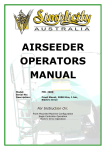
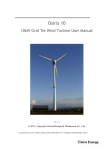
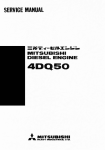
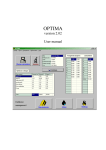
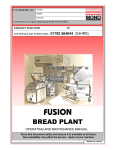
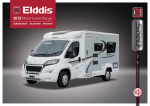

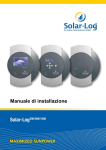
![[B40] RWS-TE2PAFZ39-IR(Videor)](http://vs1.manualzilla.com/store/data/005979657_1-986d79b0350f507a65bc366834e972e4-150x150.png)
